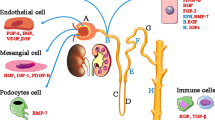Summary
In this study, we compared the serum levels of transforming growth factor-pi (TGF-β1), interleukin-10 (IL-10), and arginase-1 in long-term survival kidney transplant recipients (LTSKTRs) with those in short-term survival kidney transplant recipients (STSKTRs). We then evaluated the relationship between these levels and graft function. Blood samples were collected from 50 adult LTSKTRs and 20 STSKTRs (graft survival approximately 1–3 years post-transplantation). All patients had stable kidney function. The samples were collected at our institution during the patients' follow-up examinations between March 2017 and September 2017. The plasma levels of TGF-β1, IL-10, and arginase-1 were analyzed using enzyme-linked immunosorbent assays (ELIS A). The levels of TGF-β1 and arginase-1 were significantly higher in the LTSKTRs than in the STSKTRs. The time elapsed since transplantation was positively correlated with the levels of TGF-β1 and arginase-1 in the LTSKTRs. The estimated glomerular filtration rate was positively correlated with the TGF-β1 level, and the serum creatinine level was negatively correlated with the TGF-β1 level. Higher serum levels of TGF-pi and arginase-1 were found in LTSKTRs than in STSKTRs, and we found that TGF-β1 was positively correlated with long-term graft survival and function. Additionally, TGF-β1 and arginase-1 levels were positively correlated with the time elapsed since transplantation. On the basis of these findings, TGF-β1 and arginase-1 may play important roles in determining long-term graft survival. Thus, we propose that TGF-pi and arginase-1 may potentially be used as predictive markers for evaluating long-term graft survival.
Similar content being viewed by others
References
Sola E, Gonzalez-Molina M, Cabello M, et al. Longterm improvement of deceased donor renal allograft survival since 1996: a single transplant center study. Transplantation, 2010,89(6):714–720
Wekerle T, Segev D, Lechler R, et al. Strategies for long-term preservation of kidney graft function. Lancet, 2017,389(10084):2152–2162
Nankivell BJ, Kuypers DR. Diagnosis and prevention of chronic kidney allograft loss. Lancet 2011,378(9800): 1428–1437
Lamb KE, Lodhi S, Meier-Kriesche HU. Long-term renal allograft survival in the United States: a critical reappraisal. Am J Transplant, 2011,ll(3):450–462
Dantal J, Hourmant M, Cantarovich D, et al. Effect of long-term immunosuppression in kidneygraft recipients on cancer incidence: randomised comparison of two cyclosporin regimens. Lancet, 1998,351(9103):623–628
Legendre C, Canaud G, Martinez F. Factors influencing long-term outcome after kidney transplantation. Transpl Int, 2014,27(1): 19–27
Colak H, Ersan S, Tanrisev M, et al. Relationship of Interleukin-10 and Transforming Growth Factorbeta Levels With Short-Term Graft Function After Kidney Transplantation. Transplant Proc, 2015,47(5): 1360–1363
Luan Y, Mosheir E, Menon MC, et al. Monocytic myeloid-derived suppressor cells accumulate in renal transplant patients and mediate CD4(+) Foxp3(+) Treg expansion. Am J Transplant, 2013,13(12):3123–3131
Lees JR, Azimzadeh AM, Bromberg JS. Myeloid derived suppressor cells in transplantation. Curr Opin Immunol, 2011,23(5):692–697
Levey AS, Stevens LA, Schmid CH, et al. A new equation to estimate glomerular filtration rate. Ann Intern Med, 2009,150(9): 604–612
Haller M, Gutjahr G, Kramar R, et al. Costeffectiveness analysis of renal replacement therapy in Austria. Nephrol Dial Transplant, 2011,26(9):2988–2995
Melek E, Baskin E, Gulleroglu K, et al. The predictive value of resistive index obtained by Doppler ultrasonography early after renal transplantation on long-term allograft function. Pediatr Transplant, 2017,21(2)
Krystufkova E, Sekerkova A, Striz I, et al. Regulatory T cells in kidney transplant recipients: the effect of induction immunosuppression therapy. Nephrol Dial Transplant, 2012,27(6):2576–2582
Taams L, Vukmanovic-Stejic M, Salmon M, et al. Immune regulation by CD4+CD25+ regulatory T cells: implications for transplantation tolerance. Transpl Immunol, 2003,11(3-4):277–285
Scalea JR, Tomita Y, Lindholm CR, et al. Transplantation Tolerance Induction: Cell Therapies and Their Mechanisms. Front Immunol, 2016,7:87
Liu L, Deng S, Teng L, et al. Absolute of CD4(+) CD25(+)FOXP3(+) regulatory T-cell count rather than its ratio in peripheral blood is related to longterm survival of renal allografts. Transplant Proc, 2012,44(1):284–286
Akdis M, Blaser K, Akdis CA. T regulatory cells in allergy: novel concepts in the pathogenesis, prevention, and treatment of allergic diseases. J Allergy Clin Immunol, 2005,116(5): 961–968
Shevach EM, McHugh RS, Piccirillo C A, et al. Control of T-cell activation by CD4+ CD25+ suppressor T cells. Immunological reviews, 2001,182:58–67
Lloyd CM, Hawrylowicz CM. Regulatory T cells in asthma. Immunity, 2009,31(3):438–449
Garcia-Covarrubias L, Ventura E, Soto V, et al. Lack of Association Between Elevated Urinary Levels of Interleukin-10 and Interferon Gamma With the Presence of Inflammation in Kidney Transplant Recipients. Transplant Proc, 2016,48(2):583–587
Greten TF, Manns MP, Korangy F. Myeloid derived suppressor cells in human diseases. Int Immunopharmacol, 2011,11(7):802–807
Boros P, Ochando JC, Chen SH, et al. Myeloid-derived suppressor cells: natural regulators for transplant tolerance. Hum Immunol, 2010,71(11):1061–1066
Durante W, Johnson FK, Johnson RA. Arginase: a critical regulator of nitric oxide synthesis and vascular function. Clin Exp Pharmacol Physiol, 2007,34(9):906–911
Rodriguez PC, Quiceno DG, Zabaleta J, et al. Arginase I production in the tumor microenvironment by mature myeloid cells inhibits T-cell receptor expression and antigen-specific T-cell responses. Cancer Res, 2004,64(16):5839–5849
Rodriguez PC, Zea AH, DeSalvo J, et al. L-arginine consumption by macrophages modulates the expression of CD3 zeta chain in T lymphocytes. J Immunol, 2003,171(3): 1232–1239
Author information
Authors and Affiliations
Corresponding authors
Rights and permissions
About this article
Cite this article
Du, Xx., Guo, Yl., Yang, M. et al. Relationship of Transforming Growth Factor-βl and Arginase-1 Levels with Long-term Survival after Kidney Transplantation. CURR MED SCI 38, 455–460 (2018). https://doi.org/10.1007/s11596-018-1900-7
Received:
Revised:
Published:
Issue Date:
DOI: https://doi.org/10.1007/s11596-018-1900-7




